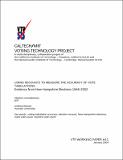| dc.contributor.author | Ansolabehere, Stephen | |
| dc.contributor.author | Reeves, Andrew | |
| dc.date.accessioned | 2015-04-14T17:05:43Z | |
| dc.date.available | 2015-04-14T17:05:43Z | |
| dc.date.issued | 2004-01 | |
| dc.identifier.uri | http://hdl.handle.net/1721.1/96548 | |
| dc.description.abstract | The 2000 presidential election exposed a surprisingly high level of inaccuracy in the tabulation of ballots. Differences between total vallots cast and votes counted were as high as 19 percent in some counties in Florida, and these discrepancies were widely attributed to the ballot formats, the handling of ballots, and machine operations. For those involved in the administration of elections the recount was particularly troubling. Over the last 40 years the United States has introduced new technologies, especially punch card and optically scanned ballots, to improve vote tabulations. The problems revealed in Florida suggested that these newer technologies may not in fact represent an improvement over traditional hand-counted paper ballots. | en_US |
| dc.description.sponsorship | Carnegie Corporation of New York; John S. and James L. Knight Foundation | en_US |
| dc.language.iso | en_US | en_US |
| dc.publisher | Caltech/MIT Voting Technology Project | en_US |
| dc.relation.ispartofseries | VTP Working Paper Series;11 | |
| dc.subject | Voting tabulation accuracy | en_US |
| dc.subject | Election recount | en_US |
| dc.subject | New Hampshire elections | en_US |
| dc.subject | Hand vote count | en_US |
| dc.subject | Machine vote count | en_US |
| dc.title | Using Recounts to Measure the Accuracy of Vote Tabulations: Evidence from New Hampshire Elections 1946-2002 | en_US |
| dc.type | Working Paper | en_US |
